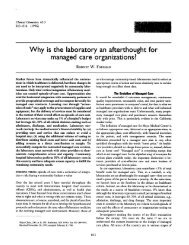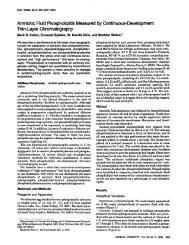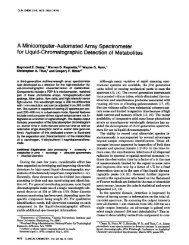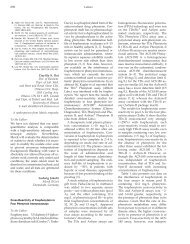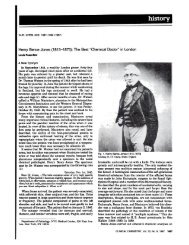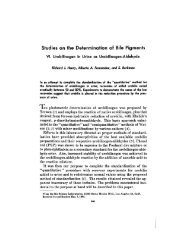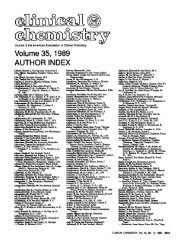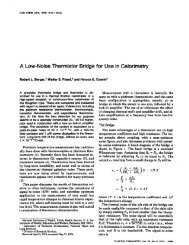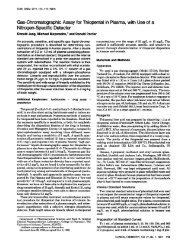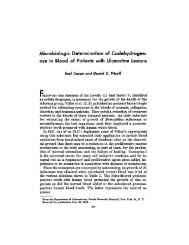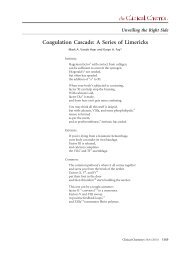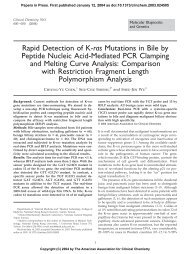View - Clinical Chemistry
View - Clinical Chemistry
View - Clinical Chemistry
You also want an ePaper? Increase the reach of your titles
YUMPU automatically turns print PDFs into web optimized ePapers that Google loves.
CLIN.CHEM.37/3, 361-368 (1991)<br />
Lipase Isoforms and Amylase lsoenzymes: Assays and Application in the Diagnosis of<br />
Acute Pancreatitis<br />
JohnA. Loftand CarrIeJ. Lu<br />
Pancreaticjuiceand serum from patients with acute<br />
pancreatitis contain three enzymes that have lipolytic<br />
activity: Li and L2,which are pancreatic isoenzymes or<br />
isoforms of lipase (EC 3.1.1.3), and L3, which is probably<br />
pancreatic carboxyl ester lipase, also known as cholesterol<br />
esterase (EC 3.1 .1.13). These enzymes are readily<br />
separated electrophoretically on agarose and can be<br />
developedwith an overlay of Kodak Ektachem lipase slide<br />
material. The latter acts as a dry-reagent developing<br />
substrate, withtheenzymes producing blue bands in the<br />
slide material. We found Li in about one-half of normal<br />
persons,L2 in none, and L3 in all. We assayed for<br />
amylase (EC 3.2.1.1), amylase isoenzymes,lipase,and<br />
lipaseisoforms in the sera of 100 patients with suspected<br />
acutepancreatitis. L2 lipasehas thegreatest diagnostic<br />
efficiency for thediagnosisof pancreatitis, compared with<br />
total amylase, P3 amylase, and total lipase. Lipase and L2<br />
could replace amylase, an inefficient test, for the diagnosis<br />
of patients with suspected acute pancreatitis. In patients<br />
receiving organ transplants, a serum amylase value<br />
of >300 U/L or a lipase of >1000 U/L discriminated well<br />
between patients with and without complications and (or)<br />
acute rejection.<br />
AddItional Keyphrases: multilayer film analysis . electrophoresis,<br />
agarose gel . organ transplants<br />
In patients with signs and symptoms of acute pancreatitis,<br />
the presence of the disease is highly likely if the<br />
serum lipase (triacylglycerol acylhydrolase; EC 3.1.1.3)<br />
values are greater than five- to 10-times the upper<br />
reference interval, if the values change significantly<br />
with time, and if the amylase (1,4-alpha-D-glucan glucanohydrolase;<br />
EC 3.2.1.1) and lipase changes are concordant.<br />
In an earlier study (1), we showed that serum<br />
lipase has about the same sensitivity but roughly twice<br />
the specificity as amylase for the diagnosis of acute<br />
pancreatitis. Massey (2) found that the P3 amylase<br />
isoenzyme in serum is particularly specific in patients<br />
with pancreatitis. In another study, we (3) reported<br />
lower specificities for P3 amylase in pancreatitis than<br />
did Massey (2).<br />
Pancreaticlipase has at least two forms, which are<br />
easilydemonstratedby using agarose gel electrophoresisfollowedby<br />
an overlayofEktachem (Eastman Kodak<br />
Co.,Rochester,NY 14650) lipase slide material (4).<br />
Abnormally increased isoenzymes nearly always pro-<br />
Department of Pathology, The Ohio State University, Columbus,<br />
OH. Address for correspondence: Starling Loving M-368,<br />
O.S.U. Medical Center, Columbus, OH 43210-1240.<br />
Received September 25, 1990; accepted January 7, 1991.<br />
vide diagnostic information that is more tissue-specific<br />
than the assay of the respective total enzyme activities;<br />
this phenomenon is well established and is exploited for<br />
diagnostic purposes for the common isoenzymes of aspartate<br />
aminotransferase, alkaline phosphatase, creatme<br />
kinase, and lactate dehydrogenase. We felt the same<br />
would be true for the lipase forms.<br />
Besides pancreatic lipase, various esterases and lipases<br />
are present in human tissues, e.g., cholesterol<br />
esterase (sterol-ester acylhydrolase; EC 3.1.1.13) and<br />
lipoprotein lipase (triacylglycero-protein acylhydrolase;<br />
EC 3.1.1.34). Esterase and lipase activities have been<br />
found in extracts of the adult liver, small intestine,<br />
gastric fluid, and tongue of newborn infants (5). Some of<br />
these enzymes have lipolytic activity and cleave the<br />
substrate that is commonly used to assay pancreatic<br />
lipase, e.g., an olive oil emulsion (6). Given the many<br />
lipases and esterases in the body, an increase in the<br />
total lipase activity in serum does not necessarily refer<br />
to the pancreas.<br />
Our goals here were to study and develop the measurement<br />
of pancreatic lipase forms by a simple electrophoretic<br />
separation method and then provide a procedure<br />
for making these forms visible. We also wanted to<br />
determine the diagnostic efficiency, sensitivity, and<br />
specificity for acute pancreatitis of total amylase, total<br />
lipase, and their isoenzymes or isoforms in the sera of<br />
patients with abnormal pancreatic enzymes and (or) a<br />
diagnosis of pancreatitis.<br />
Materials and Methods<br />
Reagents<br />
Amykzse and lipase assays in serum and tissue extracts.<br />
We used the dry-film reagent slides and procedure<br />
as provided for the KOdak Ektachem 700XR analyzer(7).<br />
Amylase isoenzymes. We used the Helena (Beaumont,<br />
TX 77704) no. 1504 electrophoresis cell and no. 5925<br />
amylase isoenzyme kit method (60 x 70 mm cellulose<br />
acetate gels) and recommended applicator, exactly as<br />
described by the manufacturer.<br />
Lipase isoforms. We used the Corning electrophoresis<br />
system (Ciba-Corning Diagnostics Corp., Palo Alto, CA<br />
94306) to separate the lipase forms, using their no.<br />
470134 celland power supply, no. 470104 SpecialPurpose<br />
Electrophoresis Film (100 x 120 mm agarose gels),<br />
and no. 470046 “MOPSO” buffer, 0.05 moilL, pH 7.8; the<br />
latter contains, per liter, 22.2 g of sodium MOPSO (/3-<br />
hydroxy-4-morpholinepropanesulfonate) and 2.3 g of<br />
MOPSO. The agarose and buffer are identical to the<br />
CLINICALCHEMISTRY, Vol. 37, No. 3, 1991 361
manufacturer’s recommended method for CK isoenzymes<br />
(8).<br />
The lipase slide material used by us is the same<br />
three-layered, dry-reagent film that is part of the Ektachem<br />
slides. The analysis of lipase is based on a totally<br />
enzymatic method, as first described by Mauck et al. (9).<br />
The lipase slide structure and reactions are described<br />
elsewhere (1). Lipase, in the presence of colipase, catalyzes<br />
the hydrolysis of 1-oleoyl-2,3-diacetylglycerol to<br />
2,3-diacetylglycerol; the latter then diffuses through the<br />
scavenger layer to the reagent layer. After several<br />
reactions (1), the final peroxidase-catalyzed reaction<br />
involves the oxidation of a leuco dye by hydrogen<br />
peroxide to produce a blue dye. The dye’s intensity is<br />
proportionalto the lipase activity. We obtained small<br />
sheets (ca. 100 mm x 200 mm) of the slide material<br />
courtesy of Eastman Kodak Co.<br />
Antibody to pancreatic lipase. A mouse IgGi monoclonal<br />
antibody to human pancreatic lipase (courtesy of<br />
Beckman Instrument Co., Brea, CA 92621) coated on<br />
4-mm-diameter polyester beads was used to test the<br />
immunochemical reactivity of lipase in serum, pancreatic<br />
juice, and tissue extracts. The beads were stored at<br />
2 to 8#{176}C.<br />
Control materials. Freshly pooled patients’ sera<br />
heated at 56 #{176}C for 1 h served as the diluent. Pure,<br />
freshly collected pancreatic fluid (see below) was diluted<br />
100-fold with the heat-inactivated serum to produce a<br />
control for both amylase, - 1000 U/L, and lipase, -5000<br />
UIL. A salivary amylase control was prepared by adding<br />
fresh human saliva to the same heat-inactivated pool to<br />
give an amylase activity of - 11 000 U/L. For the Ektachem,<br />
we also used control materials for amylase and<br />
lipase that were in routine use in the hospital laboratory.<br />
We found that 20 or 40 mm of heating at 56 #{176}C was<br />
inadequate to reduce the endogenous lipase activity of<br />
the pool to 140 UIL) or lipase (>200 U/L) by<br />
the Ektachem procedure. To investigate the changes in<br />
the enzymes in some patients with acute pancreatitis,<br />
we collected multiple specimens on successive days. A<br />
total of 272 serum specimens was collected from 100<br />
hospitalized patients. Storage, if needed, was at -20 #{176}C.<br />
Procedures<br />
Amylase isoenzymes. The electrophoretic separation<br />
of amylase isoenzymes was carried out on cellulose<br />
acetate at a constant 300 V (5 V/mm) for 1 h in a cooled<br />
cell. The amylase bands were developed with an overlay<br />
of an insoluble potato starch linked to Cibacron Blue F3<br />
GA. The dye stains the amylase bands; the stain intensity<br />
is proportional to the amylase activity. The pool<br />
containing pancreatic juice or another pool containing<br />
added saliva, both as described above, was assayed with<br />
each gel plate of specimens.<br />
Lipase isoforms. Lipase isoforms were separated by<br />
electrophoresis for 20 mm at 115 V (1.15 V/mm). Depending<br />
on the total lipase activity, 1 to 6 pL of serum<br />
specimen, control, or tissue extract was applied to the<br />
agarose wells. The total amount of lipase activity applied<br />
was such that the product, microliters of serum x<br />
lipase activity (U/L), was between 1000 and 10 000. For<br />
example, if the specimen contained lipase activity of<br />
1000 U/L, we applied 3 j.L to the agarose. The poo1with<br />
added pancreatic juice was assayed as a control on each<br />
plate.<br />
After electrophoresis, strips of Ektachem lipase slide<br />
material were placed, with the chemical reagent side<br />
down, on the agarose and incubated at 37 #{176}C for 30 mm.<br />
To ensure intimate contact between the agarose and the<br />
slide material, the elimination of air bubbles is important.<br />
After the incubation, the reagent strips were lifted<br />
from the agarose, and the slide material was allowed to<br />
dry. The lipase bands were made visible by the blue dye<br />
in the opaque reagent layer of the Ektachem lipase slide<br />
material, but the blue dye did not enter the agarose film.<br />
The isolipase bands were stable at 4 to 8 #{176}C for about<br />
2 h in the dark; they fade or smear at room temperature<br />
or in strong light. Therefore, we prepared Ektachrome<br />
transparencies of the Ektachem slide material for later<br />
densitometry. The isolipase bands in the transparencies<br />
were scanned at Kodak by using a microdensitometer<br />
with an effective slit width of 16 m. For the isolipase<br />
bands of each specimen and control, 1500 data points<br />
spaced every 10 m were taken, giving a 15-mm-wide<br />
scanned region. The blank for the microdensitometer<br />
was air.<br />
362 CLINICAL CHEMISTRY, Vol. 37, No. 3, 1991
Tissue extraction. Tissue specimens were thawed and<br />
thoroughly washed with cold (4#{176}C) distilled water. The<br />
wet tissues were laid on sponges for about 2 s to absorb<br />
any residual water, and the wet weight of each tissue<br />
specimen was determined. Tissues were washed again<br />
in cold 0.15 mol/L NaCI solution and minced with a<br />
razor blade on a piece of rough glass. The material was<br />
then hand-homogenized by using a porcelain mortar<br />
and pestle in cold pH 7.0 buffer containing, per liter, 25<br />
mmol of phosphate and 4.5 g of bovine serum albumin;<br />
the latter had no measurable amylase or lipase activity.<br />
The amount of buffer was adjusted to contain 0.1 to 0.4<br />
g of tissue per milliliter. The homogenates were centrifuged<br />
at 2600 x g and 4#{176}C for 30 mm. The supernatant<br />
solutions were stored at -20 #{176}C and thawed just prior<br />
to assay. The amylase or lipase activities in the tissue<br />
extracts were expressed as U/g of tissue, the wet<br />
weight.<br />
Reaction with monoclonal antibody. We determined<br />
the average anti-human pancreatic lipase antibody<br />
binding capacity of the Beckman anti-lipase beads, and<br />
the effect of temperature and incubation time on the<br />
binding capacity of the beads. One bead and i00-jiL<br />
aliquotsof either the lipase control described above, a<br />
tissu extract,ora patient’s serum were incubated at 25<br />
or 37 #{176}C for 1, 2, 4, and 8 h. Excess lipase was added in<br />
each case, and five replicates were examined for each<br />
experimental condition. Also, i00-/.LL aliquots of undiluted<br />
pancreatic juice were incubated with one bead<br />
each for1 or 2 h at 25 and 37 #{176}C. After the bead was<br />
added, the tube was shaken gently for -5 s, and then<br />
incubated in a water bath (25 or 37 #{176}C) for the indicated<br />
times. During the incubation period, each tube was<br />
shaken once every 20 mm.<br />
The activities of total lipase and lipase isoforms were<br />
measured before and after incubation with the bead for<br />
each sample, and the loss in lipase activity in the<br />
supernate was used to calculate the average lipase<br />
binding capacity of the beads.<br />
Results and DIscussIon<br />
Lipase Patterns in Pancreatic Juice and Serum<br />
Figure 1 shows the lipase activity patterns we observed<br />
in our control serum, i.e., the serum pool with<br />
added pancreatic juice. We saw the same lipase pattern<br />
in patients with acute pancreatitis. The most anodal<br />
band is Li and the most cathodal is L3, numbered in<br />
conformance to the convention of the International<br />
Union of Biochemistry (10). In normal subjects and in<br />
patients with pancreatitis and (or) some other disorders,<br />
L3 was always a minor band of relatively constant<br />
intensity.<br />
Lipase lsoenzymes vs Isoforms<br />
Li and L2 are probably not true isoenzymes but<br />
rather post-translational variants, i.e., isoforms. Analyzing<br />
human pancreatic juice by polyacrylamide gel<br />
electrophoresis, De Caro et al. (11) foundtwo pancreatic<br />
isolipases having isoelectric pHs of 5.80 and 5.85. By<br />
Fig. 1. Lipase isoforms Li, L2, and L3 (bottom to top, left) separated<br />
on agarose and developed with Ektachem lipase slide material in<br />
relation to the common serum proteins (tight), with albuminat the<br />
bottom<br />
Cathode (-) is at the top<br />
disk immunoelectrophoresis and Ouchterlony diffusion<br />
tests, these authors found no immunological differences<br />
between Li and L2. Our findings with the Beckman<br />
anti-lipase-coated beads agree with the notion that Li<br />
and L2 are immunologically the same.<br />
Amylase, Lipase, and Lipase Isoform Patterns in Tissues<br />
The total amylase, lipase, and lipase isoform patterns<br />
detected by the Ektachem slide material in various<br />
tissues and in diluted pancreatic fluid are shown in<br />
Table 1. Only an extract of normal duodenum showed<br />
bands that migrated to the Li and L2 positions, i.e., a<br />
pattern like that observed with the pancreatic extract or<br />
pancreatic juice. Extracts of colon and stomach gave a<br />
band that migrated to the Li position. The lipase<br />
activity in normal pancreas was much greater than that<br />
in the other tissues we examined.<br />
Immunoreactivity<br />
of Lipase Isoforms<br />
Lipase isoform binding to anti -lipase antibody beads.<br />
The anti-lipase antibody beads bound Li and L2 but not<br />
L3. In the presence of excess antibody, Li and L2 were<br />
completely removed from the pool supplemented with<br />
pancreatic fluid, but L3 remained in solution and was<br />
detected in the Kodak lipase slide material after electrophoresis.<br />
The anti-lipase antibody was prepared by starting<br />
with purified human pancreatic lipase. If we assume<br />
that the beads bind only pancreatic lipase, then L3 is<br />
not pancreatic lipase, but probably pancreatic carboxyl<br />
ester lipase, also known as cholesterol esterase. The<br />
identity of L3 remains to be confirmed. The binding<br />
capacity of the bead was about 0.4 U/bead (CV 15%) at<br />
both 25 and 37 #{176}C. The binding capacity was the same<br />
after 1, 2, or 4 h of incubation at either temperature. In<br />
the extract of duodenum, the L2 band disappeared after<br />
incubation with the anti-lipase beads. In no other tissues<br />
did we find bands that were removed by the<br />
CLINICAL CHEMISTRY, Vol. 37, No. 3, 1991 363
Pre-albumin<br />
Tissue<br />
Pancreatic fractions<br />
Pancreas<br />
Liver 6<br />
Duodenum<br />
Colon<br />
Stomach<br />
Heart 25<br />
Smallbowel<br />
Pancreas, adenocarcinoma tissue<br />
Pancreatic juice<br />
Table 1. Amylase, Llpase, and Lipase lsoenzyrnes in Tissues<br />
Electrophoretic position of the lipase bandS and % of total Ilpase activity<br />
Mostof the amylase values were below the analytical range of the Kodak method.<br />
‘ kU/L.<br />
Cathodal to<br />
Alpha-I Alpha-2 Gamma gamma<br />
Upase,<br />
U/g<br />
Amylase,<br />
U/ga<br />
Ll L2 L3<br />
50 50 Trace<br />
725<br />
835<br />
36<br />
58<br />
70.2<br />
Nontranspiantation group<br />
Acutepancreatitis8<br />
Recurrentacutepancreatitisa<br />
Chronicpancreatitisa<br />
Table 2. Demographic<br />
n<br />
30<br />
4<br />
7<br />
Uverand biliarytract diseasesa 10<br />
Diseasesof stomach,smalland<br />
largebowela<br />
Miscellaneousdisorders 21<br />
Transplantation group<br />
TotaI’<br />
Complications or acuterejection<br />
Nocomplicationsor acuterejection<br />
And additional diagnoses as shown.<br />
9<br />
10<br />
9<br />
Data of Patients In this Study<br />
Blilary<br />
tract<br />
diseases DM/DKA Trauma<br />
11<br />
0<br />
0<br />
Cholelith.<br />
1<br />
Volvulus<br />
2<br />
CAD<br />
11<br />
5<br />
0<br />
1<br />
6<br />
0<br />
0<br />
l<br />
detected<br />
Alcohol<br />
Renal<br />
abuse Cancer diseases LI U<br />
6<br />
1<br />
4<br />
Cholecyst.<br />
2 1 2<br />
1<br />
0<br />
0<br />
2<br />
0<br />
1<br />
24<br />
2<br />
5<br />
30<br />
4<br />
7<br />
DIabetes<br />
0 3 8 7<br />
Perforation<br />
4 2 1 1 3 6 7<br />
Lung<br />
dIsease<br />
6 4 2 2 5 11 10<br />
Acute<br />
reject. Infection Abscess CMV<br />
19 3 3 1 1 7 17 16 16<br />
Amylase, U/L Upase, U/L<br />
140 >300 200 >1000<br />
1 9 7<br />
0 10 9<br />
2 7 1<br />
1 8 0<br />
Patients receiving kidney only(n = 8), kidney and pancreas(n = 9), lIver (n = 1), or heart (n = 1) transplantationandadditionaldiagnosesas shown. CMV,<br />
cytomegalovirus<br />
infection; CAD, coronary artery disease;DM/DKA,diabetesmellitus/diabetic ketoacidosis.<br />
Table 3. HIghest Serum Amylase and Lipase Values in PatIents without Transplantation<br />
Amylase %P3 Upase, %L2<br />
U/L amylas. U/L llpue Diagnoses<br />
Patients s4th acute pancreatitis plus indicated diagnoses<br />
7775 25 336 000 50 MVAtraumato abdomen,<br />
duodenalperforation<br />
1480 48 31 300 46 Peritonitis,gallstones<br />
1426 20 21 800 99 Stenosisof ampullaof Vater<br />
2532 20 14 500 44 Biliarytract disease,<br />
pancreatic pseudocyst<br />
849 26 14400 37 Gallstones<br />
1064 25 14380 51 BleedIng duodenal ulcer,<br />
DKA<br />
1026 40 13940 36 Bileductobstruction<br />
1024 26 11186 55 Pancreaticpseudocyst,<br />
respiratoryfailure<br />
817 36 6413 60 Alcoholism,pancreatic<br />
pseudocyst<br />
1060 26 6310 97 Alcoholism<br />
498 0 5257 44 DM, ARF<br />
280 37 3964 48 Livernecrosis,90%<br />
third-degree bums<br />
328 0 3050 53 Cholecystilis<br />
623 43 2944 92 Gallstones,cholecystitis<br />
642 0 2705 57 Bowel obstruction<br />
227 0 2511 45 Pancreaticcancer,<br />
pancreatic pseudocyst<br />
Amylase, % P3 Upas., % U<br />
U/L amylas. U/L lipase Diagnosis<br />
484 14 2486 92 DKA<br />
160 0 2169 90 Gallstones<br />
191 32 2027 50 ARF,liverfailure,sepsis<br />
266 o i 888 40 Primarybiliarycirrhosis<br />
135 0 1774 43 Infection<br />
228 0 1770 86 MVA trauma<br />
275 0 1547 32 MVA trauma<br />
302 0 1441 42<br />
196 0 1440 43<br />
MVA trauma<br />
Pencarditis<br />
356<br />
183<br />
129<br />
0<br />
0<br />
0<br />
1215<br />
1090<br />
1024<br />
81<br />
40<br />
14<br />
Gallstones,cholecystitis<br />
Alcoholism<br />
Post-operative hematoma<br />
Patients without diagnosis of acute pancreatitis<br />
607 23 2755 48 Liver trauma<br />
304 0 1693 93 Liver necrosis<br />
508 0 1545 86 CRF,CHF,woundabscess<br />
135 0 1237 52 Necroticbowel,ARF<br />
263 17 1147 34 Pulmonary failure<br />
217 0 1132 33 Headtraumaand subdural<br />
bleeding<br />
314 0 1020 33 Pencarditis,infection<br />
ARF, acuterenal failure; CRF, chronicrenal failure; CHF, congestive heart failure; DKA, diabetic ketoacidosis; DM, diabetes mellitus; MVA, motor vehicle<br />
accident.<br />
CLINICALCHEMISTRY,Vol.37, No.3, 1991 365
15<br />
15<br />
fl26 P3 SERUM AMYLASE<br />
(1)9<br />
I.-<br />
z<br />
w<br />
C<br />
a-<br />
LL.<br />
0<br />
(1)9<br />
I- z<br />
Ui<br />
C<br />
0<br />
u3<br />
0<br />
o_O<br />
z 9<br />
15<br />
z9<br />
15<br />
H33<br />
I I I<br />
200 400 600 800 10’ t8<br />
U’L P3 AMYLASE (ELECTROPH. )<br />
15<br />
15<br />
I-<br />
1<br />
(Li<br />
C<br />
a.<br />
U.<br />
0<br />
0<br />
z<br />
9<br />
(1,9<br />
I- z<br />
Ui<br />
C<br />
a-<br />
L)<br />
0<br />
1<br />
15<br />
15<br />
0 1000 2000 3008 4800 5008 0 500 1800 1508 2000 2500<br />
U/L LIPASE (KODAK METHOD) U/L L2 LIPASE (ELECTROPH.)<br />
Fig.2. Modified Gerhardt (12) plotsfor testsin serum:amylase,P3 amylase, lipase,L2 lipase<br />
Patientswithpancreatitis (openbars)areabove thezerolineand thosewithoutthis diagnosis (stripedbars)arebelow it.ForP3 amylase,theleft-mostbar above<br />
and below thezerolinerepresents P3 amylase notbeing detected.Foramylase,lipase, and L2 lipase,thenght-mostbar forthepatients withpancreatitis includes<br />
valuesabove theupper limitshown on theabscissa. Our group of patientsconsistedof 41 patientswithand 40 withoutpancreatitis. Transplantation patientsare<br />
notincludedhere<br />
nary increases in serum lipase in all the patients but<br />
only modest increases in the serum amylase in some of<br />
the patients with pancreatitis. Also here are data on<br />
patients without a diagnosis of pancreatitis but who had<br />
lipase values >1000 U/L; these persons had complex<br />
and (or) serious conditions.<br />
In two of seven patients with chronic pancreatitis, the<br />
amylase in serum was always
Test<br />
Amylase<br />
Amylase P3<br />
Lipase<br />
Table 4. Sensitivity, Specificity, and Diagnostic<br />
EffIciency of Tests for Pancreatitis<br />
DIagnostic<br />
SensItivIty Specificity efficIency<br />
Lipase L2<br />
ri<br />
Cutoff,<br />
U/L<br />
100<br />
200<br />
300<br />
400<br />
500<br />
100<br />
200<br />
300<br />
200<br />
400<br />
600<br />
800<br />
1000<br />
100<br />
200<br />
400<br />
600<br />
800<br />
1000<br />
93 15<br />
63 50<br />
46 73<br />
37 78<br />
32 85<br />
29 95<br />
24 100<br />
7 100<br />
100 30<br />
90 48<br />
83 65<br />
80 75<br />
71 83<br />
93 53<br />
80 73<br />
71 88<br />
61 90<br />
49 93<br />
46 93<br />
54<br />
57<br />
58<br />
57<br />
58<br />
62<br />
62<br />
53<br />
65<br />
69<br />
74<br />
78<br />
77<br />
73<br />
77<br />
79<br />
75<br />
70<br />
69<br />
Abnormal pancreatic enzymes are to be expected in<br />
patients with renalfailure or in cases of kidney rejection.<br />
Patients having organ transplantation. Results for<br />
amylase, P3 amylase, lipase, and L2 lipase in serum<br />
from patientshaving organ transplantation are shown<br />
in Figure 4. In nearly all cases, thesepancreaticenzymes<br />
were abnormally increased after kidney, simultaneous<br />
kidney and pancreas, liver, or heart transplantation<br />
surgery. We excluded from Figure 4 data from<br />
two patients whose blood specimens were obtained less<br />
than two days after their transplantation surgery. By<br />
“complications,” we include acute or subacute organ<br />
rejection, cytomegalovirus and other infections, and<br />
cyclosporin toxicity. A serum amylase value>300 U/L<br />
or a lipase >1000 UIL discriminated well between<br />
LIDSS. x URL Amylase x URL<br />
ii: :;:. ::<br />
Conclusions<br />
The estimation of the three lipase isoenzymes in<br />
serum by the overlay of KOdak Ektachem lipase slide<br />
material on agarose electrophoretic plates does not<br />
require complex equipment.Three lipase isoforms are<br />
present in pancreatic fluid, two of which-Li and L2-<br />
appear to be pancreatic lipase, as determined by their<br />
reactivity with human anti-pancreatic lipase antibody.<br />
We found Li in some normal persons, L2 in none, and<br />
L3 in all; the latter is probably pancreatic carboxyl ester<br />
lipase, which is present in serum in apparently constant<br />
amounts in normal persons and in patients with pancreatitis<br />
and (or) a host of other abdominal disorders, as<br />
in the patient cohort described here.<br />
Days (5 20 25 All patientswith pancreatitis showed the L2 form, and<br />
Fig. 3. Lipase(#{149}) andamylase(0) in serumin a patientwith acute about two-thirds of patients without a diagnosis of pancreatitis<br />
but with some acute abdominal disorder also<br />
pancreatltis,showingcharacteristicchangeswith time<br />
The ordinatesshow multiples of the upper reference limit (URL) for amylase had increased amounts of L2 in serum. Some patients<br />
(right
For the diagnosis of pancreatitis, lipase and L2 have<br />
essentially the same sensitivity-90% to 100%-if appropriate<br />
cutoff values are used, but L2 has better<br />
diagnostic efficiency. When lipase in serum is increased<br />
above fivefold normal, i.e., >1000 U/L, pancreatitis (or<br />
organ rejection in transplant patients) is highly likely.<br />
The presence of acute pancreatitis is unlikely if the<br />
lipase never exceeds 500 to 600 U/L. Serum amylase<br />
exhibited a lower sensitivity than lipase. Amylase P3<br />
isoenzyme had poor sensitivity but good specificity for<br />
pancreatitis. Arnylase is a poor test in the diagnosis of<br />
pancreatitis; better choices would be the lipase test,<br />
because of its higher sensitivity, and L2 lipase or possibly<br />
P3 amylase, because of their greater specificity.<br />
We thank Patty Warren of the O.S.U. <strong>Clinical</strong> <strong>Chemistry</strong><br />
Laboratory, Arthur Weeks and Clara Murray of the photography<br />
laboratory, and Dr. Han-Ping Wang of Beckman Instrument Co.,<br />
Brea, CA, for his gift of the anti-lipase antibody-coated beads.We<br />
also thank Steven Dr Smitt and Dr. Glenn Dappenof Eastman<br />
Kodak for performing the densitometry of the isoenzyme patterns,<br />
and Dr. Gary Norton and Tom Arter of Kodak for providing the<br />
Ektachem lipase slide material.<br />
References<br />
1. Lott JA, Patel ST, Sawhney AK, Kazmierczak SC, Love JE Jr.<br />
Assays of serumlipase:analytical and clinical considerations.Clin<br />
Chem 1986;32:1290-302.<br />
2. Massey TH. Efficiency in the diagnosis of acute pancreatitis<br />
increased by improved electrophoresis of amylase isoenzyme P3 on<br />
cellulose acetate. Cliii Chem 1985;31:70-5.<br />
3. Lott JA, Ellison EC, Applegate D. The importance of objective<br />
data in the diagnosisof pancreatitis. Clin Chim Acta 1989;183:33-40.<br />
4. Miller IL, Lott JA. Lipase: total and isoenzyme activities in<br />
normal human tissues [Abstract]. Clin Chem 1988;34:1289.<br />
5. BorgstrOm B, Brockinan IlL, eds. Lipases. New York: Elsevier<br />
Science PublishersB.V., 1984:49-416.<br />
6. Lundstrom MB, Sternby B, Borgstrom B. Concerted action of<br />
human carboxyl ester lipase and pancreatic lipase during lipid<br />
digestion in vitro: importance of the physiochemical state of the<br />
substrate. Biochim Biophys Acta 1988;959:178-84.<br />
7. Serum lipase procedure for the Ektachem. Eastman Kodak Co.,<br />
<strong>Clinical</strong> Products Division, Kodak Park, Rochester, NY 14560.<br />
8. Ciba-Corning procedure for CK isoenzymes. Ciba Corning Diagnostics<br />
Corp., Medfleld, MA 02052.<br />
9. Mauck JC, WeaverMS, Stanton C. Development of a Kodak<br />
Ektachemclinical chemistryslidefor serum lipase [Abstract].Clin<br />
Chem 1984;30:1058-9.<br />
10. IUB NomenclatureCommittee.Enzymenomenclature 1984.<br />
New York: Academic Press, Inc., 1984.<br />
11. Dr Care A, Figarella C, Amic J, et al. Human pancreatic<br />
lipase: a glycoprotein. Biochim Biophys Acta 1977;490:411-9.<br />
12. Gerhardt W. The Bayes approach: systematic graphic evaluation<br />
of diagnostic tests. In: Keller H, Trendelenburg CH, eds. Data<br />
presentation, interpretation. New York: Walter de Gruyter & Co.,<br />
1989:161-204.<br />
13. Royce VL, Jensen DM, Corwin HL. Pancreatic enzymes in<br />
chronic renal failure. Arch Intern Med 1987;147:537-9.<br />
14. ZacheeP,Lins RL, Dr Broe ME. Serum amylase and lipase<br />
values in acute renal failure [Letter]. Clin Chem 1985;31:1237.<br />
368 CLINICAL CHEMISTRY, Vol. 37, No. 3, 1991




